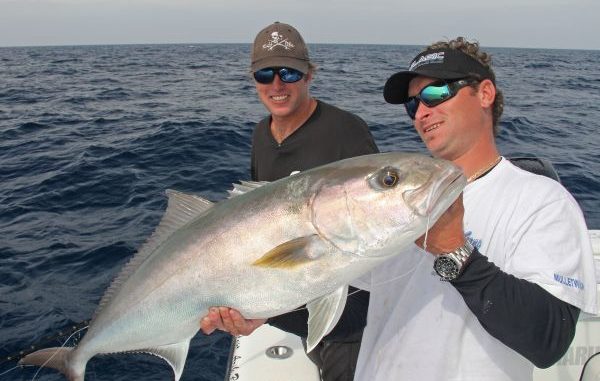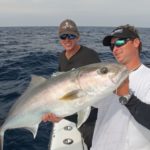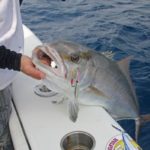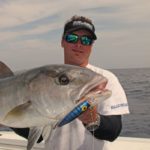
Amberjacks are short on pretty, but long on brutality. Here’s how to gear up to do battle with these bullies of the Gulf
If you’re looking for fancy, graceful or aesthetically pleasing, amberjacks will disappoint you. If, on the other hand, an arm-stretching, back-straining lesson in brutality sounds fun, you’ll really enjoy hanging out with the fish marine biologists call Seriola dumerili.
With big, toothless mouths made for wolfing down hefty meals in single gulps and long, muscular physiques built for pure, unmitigated power, the amberjack dishes out battles of epic proportions.
As for table fare, amberjack won’t replace snapper or tuna anytime soon; but these brown bullies yield a respectable meal in smoked, grilled or blackened form.
Running out of Venice Marina, Hunter Caballero of Paradise Outfitters looks for AJs in water depths of about 250 to 800 feet.
He fishes a selection of natural bottom, wrecks, and the ever-popular and consistently productive Midnight Lump off Southwest Pass.
But tops for him are those metal mountains conducting the business of oil and gas collection.
Emergent rigs are obvious, but he’s also keen to fish those retired “cut-off” rigs whose topside structures have long departed, leaving only the submerged legs. Similarly, the work of hurricanes has also dismantled some of the northern Gulf’s rigs and created artificial reefs that AJs find appealing.
“They’re still marked on your GPS, but they might be 100 yards away,” Caballero said of the displaced rigs. “You can still find them, but they just don’t get as much pressure.”
Here are thoughts from veteran amberjack chasers.
Mix it up for amberjack fishing
Florida AJ specialist Capt. Jesse James Mayer offered a roundup of alternative tactics to make the game a little more interesting.
A diverse menu of options, Mayer said, affords maximum opportunity to maximize this sporty game fish’s potential.
“Once you get into them, you get into a bunch of them,” Mayer said. “They fight hard, they pull a lot of drag and they eat just about anything.”
Trolling: Over reefs, wrecks or cutoff rigs, as well as around the perimeters of emergent rigs, pulling rigged ballyhoo will bring hungry AJs running.
Also, if barracuda are intercepting your live baits dropped to the target site, pull 100 yards away, deploy a couple of rigged hardtails on downriggers and troll them into the active zone — under the toothy fish’s radar.
Jigs: Mayer employs specialized jigging rods made for the sharp, rapid action that makes a butterfly jig or diamond jig resemble a wounded baitfish.
The dynamics of a heavy jig with a dangling hook harness (or a big treble, as with diamond jigs) give head-shaking AJs plenty of opportunities to throw the bait.
However, anytime a hooked fish unbuttons his jig, Mayer keeps the bait in play for the next willing player.
Plugs: Unquestionably the most-exciting way to catch amberjack is working a big surface popper that will unleash the AJs inner beast with spectacular drama.
Obviously a tactic reserved for fish that have already headed topside in response to chumming efforts (see Action & Appetizers) or a hooked fish, this is a case of more-is-better.
With a heavy-action spinning outfit, fling a big plug off the stern, rip it vigorously and hang on tightly because this is one of those times when a fish will literally take the rod right out of your hands.
Fly Casting: Another cool way to entice surface-oriented AJs is to employ a 10-weight rod and a chartreuse streamer.
You’ll rarely need to make anything more than simple roll casts, but be ready to strike hard and get your stripping hand clear, lest a fleeing AJ leave you with a nasty burn blister.
Amberjack battle royale
Venice’s Capt. Hunter Caballero said the spot he fishes determines his AJ fight plan. Specifically, emergent rigs require an immediate angler-assistance move.
“If you’re fishing a permanent rig above the water line, you always want to pull the fish off the rig so he doesn’t get you down in the (legs) and cut you off,” he said. “When we hook up, we back the boat away. You have to have 2 or 3 of your buddies hold on to you, because we take off.”
Caballero said the strategy changes for cutoff rigs. He doesn’t power back on the strike, but the cutoff risk remains so prudent response is paramount.
“It’s up to the angler to get the fish to the surface, but you can’t give him an inch because he’ll try to pull you down and cut you off,” he said.
Caballero said fighting belts greatly facilitate the fight, but that’s mostly for rod control. Locking the rod butt into the gimbal keeps it centered and therefore easier to manage.
A belt does not, however, relieve you of the relentless force that is an amberjack.
“Hang on tight, because when you think you have him beat he’ll just about yank you out of the boat,” Caballero said. “That’s why we always have someone holding on to the angler from behind.”
Florida’s Capt. Jesse James Mayer’s fellow AJ hunter, Capt. Dane Karcher said the successful AJ fight blends force with finesse — not in the delicate way but in the tactical sense.
“Try to lead them up by their head,” Karcher said. “When they run away from you, let them run, and when they stop, you try to get their head coming your way.
“I like to use a good amount of drag and keep the line as tight as you can. When you feel them stop running, that’s when you want to start using short pumps. You’ll only gain an inch or two at a time, but you’ll gain a little more each time. Eventually, you’ll lead them right to you.
“It’s kind of like leading a horse.”





